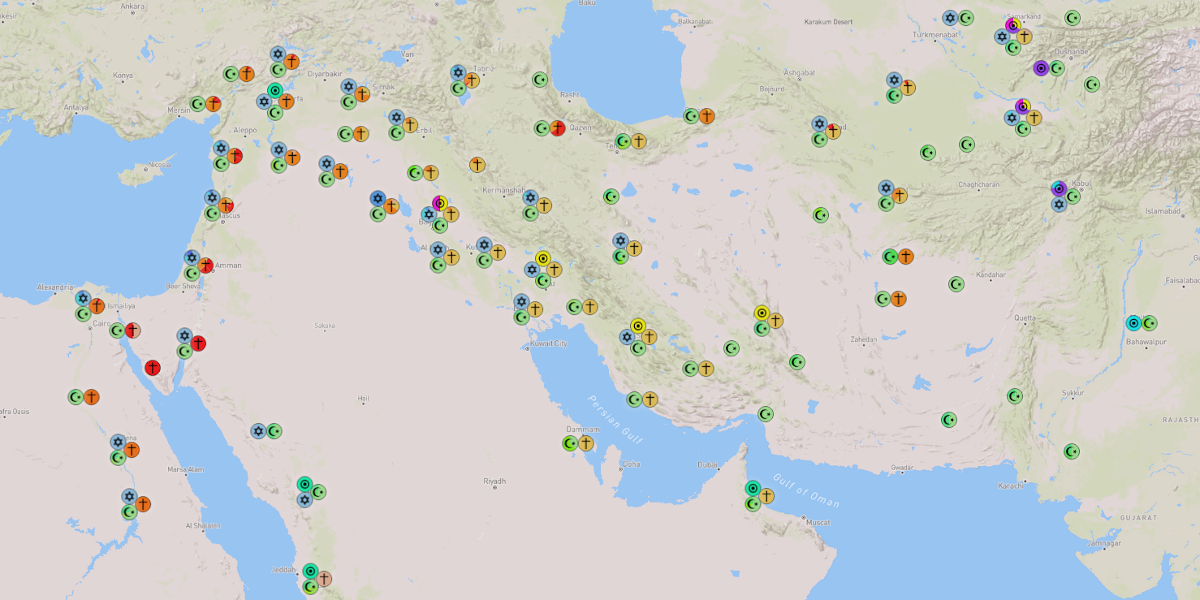The database of Damast provides data mainly from approved works of reference, which were each compared, evaluated and corrected by the team of researchers.
The following works are included:
AtKG — Jedin, Hubert, and Jochen Martin, eds. Atlas zur Kirchengeschichte: Die Christlichen Kirchen in Geschichte und Gegenwart. Freiburg: Herder, 1987.
CoptEnc — Atiya, Aziz S., ed. The Coptic Encyclopedia. 8 vols. New York: Macmillan, 1991. https://ccdl.claremont.edu/digital/collection/cce.
Crown — Crown, Alan David, ed. The Samaritans. Tübingen: Mohr, 1989.
DHGE — Aubert, Roger, and Luc Courtois, eds. Dictionnaire d’histoire et de géographie ecclésiastiques. Paris: Letouzey et Ané, 1912–.
EI — Houtsma, Martijn Th., Thomas W. Arnold, René Basset, and Richard Hartmann, eds. Encyclopaedia of Islam, First Edition. Leiden: Brill, 1913–1936. https://referenceworks.brillonline.com/browse/encyclopaedia-of-islam-1.
EI² — Bearman, Peri J., Thierry Bianquis, Clifford E. Bosworth, Emeri J. van Donzel, and Wolfhart P. Heinrichs, eds. Encyclopaedia of Islam, Second Edition. Leiden: Brill, 1960–2004. https://referenceworks.brillonline.com/browse/encyclopaedia-of-islam-2.
EI³ — Fleet, Kate, Gudrun Krämer, Denis Matringe, John Nawas, and Everett Rowson, eds. Encyclopaedia of Islam, THREE. Leiden, 2007–. https://referenceworks.brillonline.com/browse/encyclopaedia-of-islam-3.
EIr — Yarshater, Ehsan, ed. Encyclopaedia Iranica. New York: Encyclopaedia Iranica Foundation, 1982–. https://www.iranicaonline.org/.
EJ — Berenbaum, Michael, and Fred Skolnik, eds. Encyclopaedia Judaica. 2nd ed. 22 vols. Detroit: Macmillan, 2007.
EJIW — Stillman, Norman A., ed. Encyclopedia of Jews in the Islamic World. 5 vols. Leiden: Brill, 2010.
Hamilton — Hamilton, Bernard. The Latin Church in the Crusader States: The Secular Church. London: Variorum Publications, 1980.
Hromklay 1179 — Tékéyan, Pascal. Controverses christologiques en Arméno-Cilicie dans la seconde moitié du XIIe siècle (1165–1198). Orientalia Christiana Analecta 124. Rome: Pontificium Institutum Orientalium Studiorum, 1939.
OrChrN — Fiey, Jean Maurice. Pour un Oriens Christianus novus: Répertoire des diocèses Syriaques orientaux et occidentaux. Beiruter Texte und Studien 49. Stuttgart: Steiner, 1993.
PMBZ — Lilie, Ralph-Johannes, Claudia Ludwig, Beate Zielke, and Thomas Pratsch. Prosopographie der mittelbyzantinischen Zeit. Edited by Berlin-Brandenburgische Akademie der Wissenschaften, 2013. https://doi.org/10.1515/pmbz.
Richter-Bernburg — Richter-Bernburg, Lutz. St. John of Acre – Nablus – Damascus: The Samaritan Minority Under Crusaders and Muslims.
In Die Folgen der Kreuzzüge für die orientalische Religionsgemeinschaften. Edited by Walter Beltz, 117–130. Hallesche Beiträge zur Orientwissenschaft 22. Halle, 1996.
Schick — Schick, Robert. The Christian Communities of Palestine from Byzantine to Islamic Rule: A Historical and Archaeological Study. Studies in Late Antiquity and Early Islam 2. Princeton, NJ: Darwin Press, 1995.
TIB2 — Hild, Friedrich, and Marcell Restle. Kappadokien (Kappadokia, Charsianon, Sebasteia und Lykandos). Tabula Imperii Byzantini 2. Wien: Verlag der Österreichischen Akademie der Wissenschaften, 1981.
TIB5 — Hild, Friedrich, and Hansgerd Hellenkemper. Kilikien und Isaurien. 2 vols. Tabula Imperii Byzantini 5. Wien: Verlag der Österreichischen Akademie der Wissenschaften, 1990.
TIB15 — Todt, Klaus-Peter, and Bernd A. Vest. Syria (Syria Prōtē, Syria Deutera, Syria Euphratēsia). 3 vols. Tabula Imperii Byzantini 15. Wien: Verlag der Österreichischen Akademie der Wissenschaften, 2014.
Timm — Timm, Stefan. Das christlich-koptische Ägypten in arabischer Zeit: Eine Sammlung christlicher Stätten in Ägypten in arabischer Zeit, unter Ausschluß von Alexandria, Kairo, des Apa-Mena-Klosters (Dēr Abū Mina), der Skētis (Wādi n-Naṭrūn) und der Sinai-Region. 7 vols. Beihefte zum Tübinger Atlas des Vorderen Orients 41. Wiesbaden: Reichert, 1984.
Vest — Vest, Bernd A. Geschichte der Stadt Melitene und der umliegenden Gebiete: Vom Vorabend der arabischen bis zum Abschluß der türkischen Eroberung (um 600 – 1124). 3 vols. Byzanz, Islam und Christlicher Orient 1. Hamburg: Kovač, 2007.
Note that due to the data represented so far in works of reference our geographical location and our dating is less comprehensive for Jewish and Samaritan communities.
A next stage would be to include more data from detailed research.
Additionally, we have included the following medieval sources to represent Jews, Christians and Muslims respectively:
Benjamin eng / Benjamin heb — Benjamin of Tudela. The Itinerary of Benjamin of Tudela. Critical text, translation and commentary by Marcus Nathan Adler. New York: Feldheim, 1907.
Muqaddasi ara — al-Muqaddasī, Muḥammad b. Aḥmad. Aḥsan at-taqāsīm fī maʿrifat al-aqālīm. Edited by Michael J. de Goeje. 2nd ed. Bibliotheca Geographorum Arabicorum 3. Leiden: Brill, 1906. Parallel title: Descriptio imperii Moslemici auctore [...] al-Moqaddasi.
Muqaddasi eng — al-Muqaddasī, Muḥammad b. Aḥmad. The Best Divisions for Knowledge of the Regions. A Translation of Aḥsan al-Taqāsīm fī Maʿrifat al-Aqālīm. Translated by Basil A. Collins. Great Books of Islamic Civilisation. Reading, UK: Garnet, 1994.
Sis 1307 lat — Balgy, Alexander. Historia doctrinae catholicae inter Armenos unionisque eorum cum Ecclesia Romana in Concilio Florentino. Vienna: Typis Congregationis Mechitharisticae, 1878, 303–311. https://archive.org/details/HistoriaDoctrinaeCatholicaeInterArme.
Sis 1307 arm — Palčean, Ałekʿsandr V. Patmutʿiwn katʿołikē vardapetutʿean i Hays ew miutʿean nocʿa ənd Hṙomeakan ekełecʿwocʿ i Pʿlorentean siwnhodosi. Wien: Typis Congregationis Mechitharisticae, 1878, 274–281. https://archive.org/details/PalcheanPatmutiwnKatoghikeVardapetutean.
Adana 1316 lat — Balgy, Alexander. Historia doctrinae catholicae inter Armenos unionisque eorum cum Ecclesia Romana in Concilio Florentino. Vienna: Typis Congregationis Mechitharisticae, 1878, 333. https://archive.org/details/HistoriaDoctrinaeCatholicaeInterArme.
Adana 1316 arm — Palčean, Ałekʿsandr V. Patmutʿiwn katʿołikē vardapetutʿean i Hays ew miutʿean nocʿa ənd Hṙomeakan ekełecʿwocʿ i Pʿlorentean siwnhodosi. Wien: Typis Congregationis Mechitharisticae, 1878, 197–198. https://archive.org/details/PalcheanPatmutiwnKatoghikeVardapetutean.
Sis 1342 lat — Tăutu, Aloysius L., ed. Acta Benedicti XII (1334–1342). E regestis Vaticanis aliisque fontibus collegit. Fontes, Series III 8. Rome: Typis Polyglottis Vaticanis, 1958, 160–161.
Munier — Munier, Henri. Recueil des listes épiscopales de l’église Copte. Cairo: Société d’archéologie copte, 1943.
Smbat 1199 fra — Smbat Sparapet. La chronique attribuée au connétable Smbat. Introduction, traduction et notes par Gérard Dédéyan. Documents relatifs à l'histoire des croisades publiés par l'Académie des inscriptions et belles-lettres 13. Paris: Geuthner, 1980.
Benedictus PP. XII — Tăutu, Aloysius L., ed. Acta Benedicti XII (1334–1342). E regestis Vaticanis aliisque fontibus collegit. Fontes, Series III 8. Rome: Typis Polyglottis Vaticanis, 1958.





